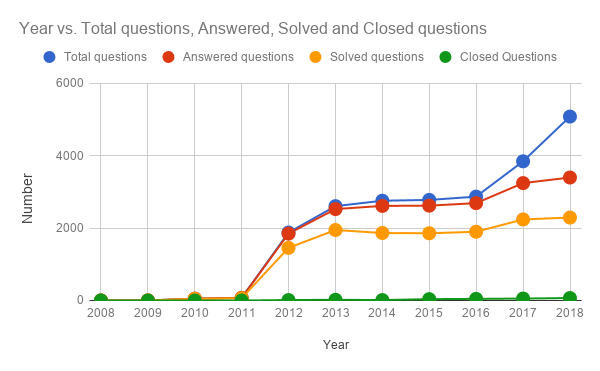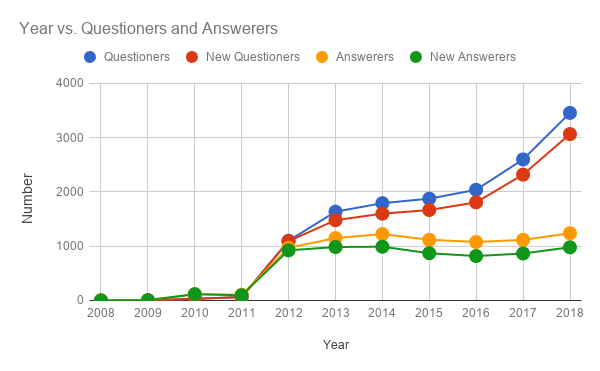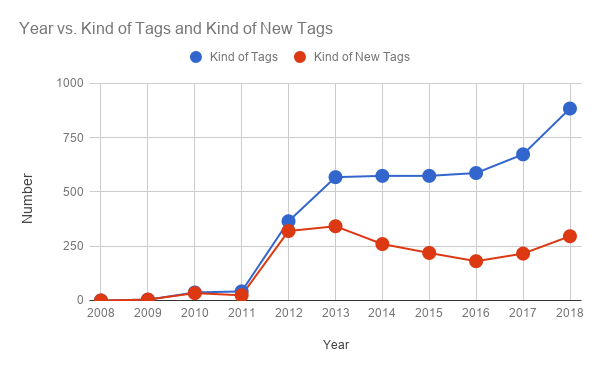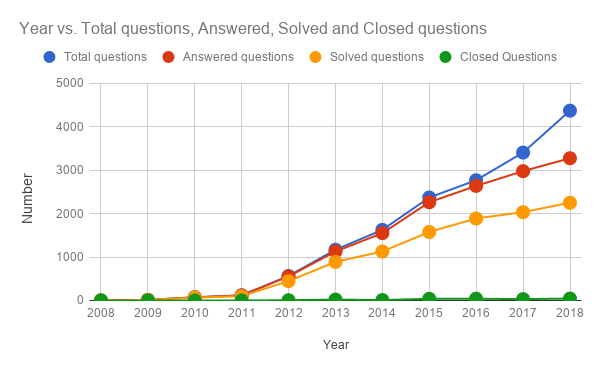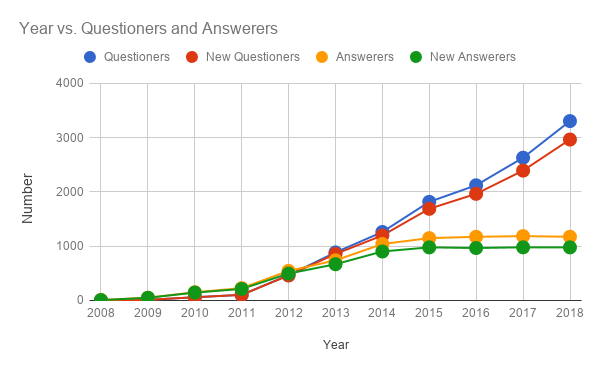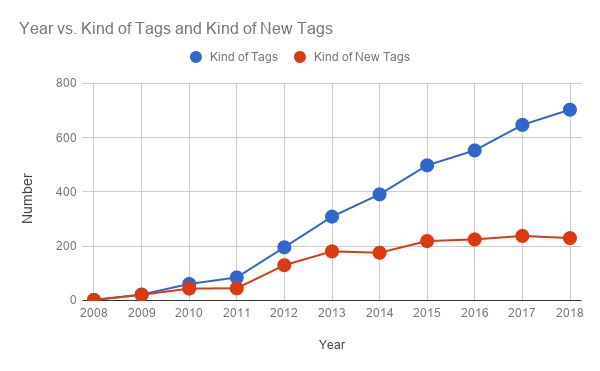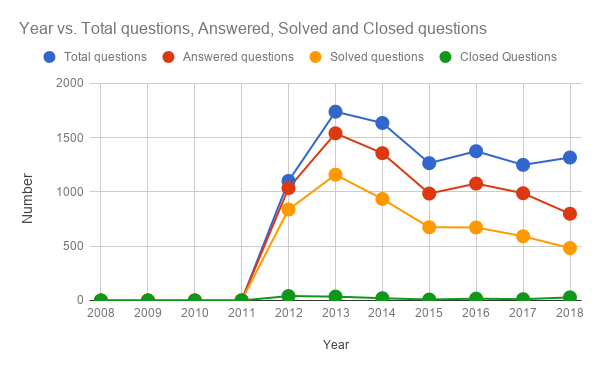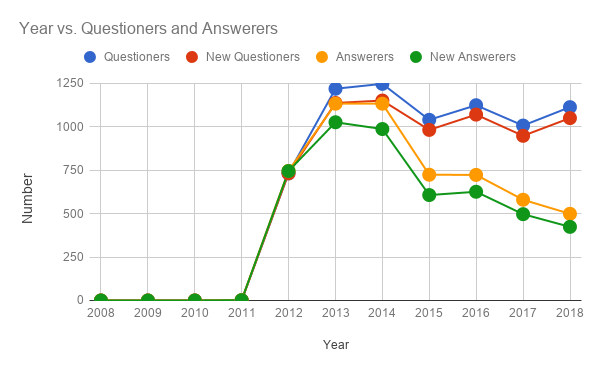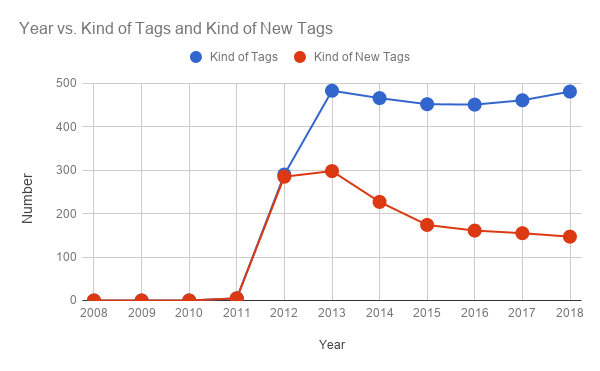Kanshi Tanaike
At Stackoverflow, a lot of people post the questions and answers to the questions every day. There are various tags in Stackoverflow. A lot of discussions are performed at each tag. Their discussions bring the important information and are much useful for a lot of people. As one of tags, there is "google-apps-script". I sometimes discuss at the questions with that tag. When we see the discussions, we can notice that the discussions are changed and progressed by the time, because "Google Apps Script" which is the origin of the tag is updated. This report thinks this change as the trend of tag of "google-apps-script". This trend includes the number of questions, questioners, answerers and tags adding to the tag of "google-apps-script". The trend of tag of "google-apps-script" is deeply related to the progression of Google Apps Script and the various applications for Google Apps Script.
In this report, as one of several approaches, the trend of Google Apps Script was investigated by statistically analyzing all questions with the tag of "google-apps-script". As the result, it was found that by investigating all questions with the tag of "google-apps-script", the tags added to this main tag strongly affected to the trend of the tag of "google-apps-script". Also the possibility which can estimate the future trend by investigating the tags adding to the tag of "google-apps-script" was indicated.
At first, the history of Stackoverflow and Google Apps Script is confirmed. The following list shows the history of Stackoverflow and Google Apps Script.
- 2008-09-15: Stackoverflow was launched. Ref. 1
- 2009-08-19: Google Apps Script was released. Ref. 2
- 2011-08-29: Tag of "google-apps-script" was created in Stackoverflow. Ref. 3
- How to get help of the official document says "We use the popular programming Q&A website Stack Overflow to field technical questions.".
From this list, it is found that the history of Stackoverflow is older than that of Google Apps Script, and also the tag of "google-apps-script" at Stackoverflow is introduced by the Google's official document. These indicate that a lot of information about the history of Google Apps Script can be obtained from all questions with tag of "google-apps-script" in Stackoverflow.
All questions and the related data can be retrieved by a tag using Stack Exchange API. Ref. 4 In this report, "google-apps-script" was used as the base tag. All questions including the tag of "google-apps-script" at Stackoverflow were retrieved by the API, and the retrieved data from 2008-01-01 to 2019-01-01 was statistical analyzed. At Stackoverflow, users can edit the old questions and answers. So please be careful that the data which introduce in this report is the data when was retrieved. The data used in this report was retrieved at 2019-03-25 14:39.
Fig. 1. Year vs. Total questions, answered, solved and closed questions. These all questions include the tag of "google-apps-script" in the tags.
Figure 1 shows the time dependence on the total questions and answered, solved and closed questions. These all questions include "google-apps-script" in the tags. Although the tag of "google-apps-script" was created at 2011-08-29, the total questions at 2009 are 2. This is due to adding the tag after the tag was created. From Fig. 1, it is found that the number of questions increases every year. And you can see the following 3 features for each solid line.
- Numbers of total questions, answered and solved questions drastically increase at 2012.
- Numbers of total questions, answered and solved questions shows almost no change from 2013 to 2016.
- Numbers of total questions, answered and solved questions drastically increase at 2017.
On the other hand, the closed questions shows almost no change from 2010 - 2018. It was found that the closed questions were about 1.2 % for the total questions every year in the average. 3 features can be also seen at the time dependence on the number of questioners and answerers as shown in Fig. 2.
Fig. 2. Year vs. number of Questioners and Answerers. These all questions include the tag of "google-apps-script" in the tags.
The numbers of "Questioners" and "Answerers" were calculated for each year. In this case, for example, if one user, who is "sampleUser", posts 1 question at 2017 and 2018, respectively, each post is counted in each year. "New Questioners" and "New Answerers" mean all questioners and answerers without duplicating for all years. So that means that "sampleUser" posted a question or answered in 2018 has never posted and answered from 2008 to 2017.
From Fig. 2, it was found that the repeater users and new users increase every year, and new users are 93 % in the average of all questioners at each year and 86 % in the average of all answerers for each year, respectively. From Fig. 2, the following situations can be seen.
- Numbers of both questioners and answerers drastically increase at 2012.
- Number of questioners increases while number of answerers decreases at 2013 - 2016.
- Numbers of both questioners and answerers show the increasing trend at 2017. But the change of number of answerers is smaller than that of questioners.
Fig. 3. Year vs. Kind of Tags and Kind of New Tags. Here, "New Tags" means the tags without duplicating for all years. For example, "google-sheets-macros" added in 2018 is not used from 2008 to 2017. It appeared in 2018 for the first time.
Next, a chart taken for investigating the time dependence on the number of "Kind of Tags" and "New Tags" is shown in Fig. 3. "Kind of Tags" means that the number of kinds of tags used every year. On the other hand, "New Tags" means the tags without duplicating for all years. For example, "google-sheets-macros" which was added in 2018 is never used from 2008 to 2017. It means that the tag appeared in 2018 for the first time. At this time, 1 is counted for "New Tags" of 2018. From Fig. 3, the following situation can be seen.
- Numbers of both "Kind of Tags" and "New Tags" drastically increase at 2012.
- Number of "Kind of Tags" shows almost no change while number of "New Tags" decreases at 2013 - 2016.
- Numbers of both "Kind of Tags" and "New Tags" show the increasing trend at 2017. But the change of number of "New Tags" is smaller than that of "Kind of Tags".
From Figs. 1, 2 and 3, the three features at 2012, 2013 - 2016 and 2017 can be considered as follows.
- About the trend at 2012, when it thinks of the situation that the tag of "google-apps-script" was created at 2011-08-29, it is considered that by releasing Google Apps Script and adding the tag, the reason is due to increasing users who use Google Apps Script at that year. By increasing users, the questions, answers, tags increase.
- About the trend at 2013 - 2016, it is considered that almost no change of the number of users leads to almost no change of the number of questions. About the reason of no change, it is considered that the reduction of "New Tags" might bring the trend shown at 2013 - 2016.
- About the trend at 2017, the increase of users leads to the increase of questions. It is considered that this might be due to the increase of "New Tags".
Here, from Figs. 1 - 3 and the consideration, it was speculated that increasing the number of "New Tags" leads to the increase of users. In order to confirm this, it was statistically analyzed with the following flow.
-
Retrieve all kinds of tags, which were used in the year, every year.
- In this report, the data retrieved from 2008 to 2018 were used.
-
Retrieve tags which firstly appeared as new tag, which is not duplicated for all years, in each year.
- Here, "new tags" means the tags without duplicating for all years. For example, if there is a tag of "sample tag" which was used in 2018 for the first time, it means that that is not used from 2008 to 2017. It was used in 2018 for the first time.
-
Retrieve history of tags.
- About new tags, retrieve the number of use of each tag for each year.
- For example, in the case of the tag of "google-apps-script" which was used in 2009 for the first time, the number of use of the tag is retrieved for 2009 - 2018. For 2009 - 2018, those are 2, 50, 72, 1878, 2607, 2757, 2779, 2870, 3846 and 5082 respectively. This means that the tag of "google-apps-script" has 10 histories.
-
Calculate the trend of the history of tags.
- As one of several methods for quantitatively evaluating the trend of tag, from the data, I proposed that the following simple method.
-
The numbers of use of new tags for each year were summed and the average was calculated. The equation expressed this is as follows.
where Atag is the average value of the number that a new tag was used at each year. So for example, if the new tag appears in 2014, the average value is calculated for 2014 - 2018. n means the history of tag. For example, in the case of the tag of "google-apps-script", Atag becomes
(2 + 50 + 72 + 1878 + 2607 + 2757 + 2779 + 2870 + 3846 + 5082) / 10 = 2194.3.
-
- As one of several methods for quantitatively evaluating the trend of tag, from the data, I proposed that the following simple method.
Table 1 shows the new tags which were added at 2008 - 2018. The top 10 tags with the average value by calculated the trend of the history of tags for each year were displayed.
Table. 1. New tags added at 2008 - 2018. Top 10 tags with the average value by calculated the trend of the history of tags for each year were retrieved. At 2018, new tags have only one history, because the data of 2019 cannot be retrieved. Number in "()" is the value of Atag.
| Year | New tags (Order of Atag) |
|---|---|
| 2008 | |
| 2009 | google-apps-script(2194.3), google-sheets(795), google-form(110.7), java(5.1) |
| 2010 | javascript(530.4), google-docs(94.8), google-apps(70.2), google-spreadsheet-api(61.1), google-calendar-api(40.1), spreadsheet(31.4), json(31), google-api(30.4), google-sites(30.2), google-docs-api(23.2) |
| 2011 | google-drive-sdk(107.4), html(88.5), gmail(61.1), email(38.1), forms(22.1), google-app-engine(11.6), oauth(11.1), jdbc(10.6), php(10.3), mysql(8.8) |
| 2012 | google-sheets-api(60.7), arrays(60.1), triggers(43.9), jquery(36.4), google-visualization(24.6), gmail-api(21.4), excel(20.6), google-bigquery(18.9), date(16.4), gsuite(16) |
| 2013 | google-apps-script-addon(16.7), google-admin-sdk(15), loops(11.3), if-statement(10.5), android(8.8), export-to-pdf(7.5), firebase(6.2), web-scraping(6), google-chrome-extension(5.8), replace(5.7) |
| 2014 | google-cloud-platform(8.2), scriptdb(5), google-directory-api(4), webhooks(3.6), telegram(3.3), youtube-data-api(3), google-email-migration(3), duplicates(3), date-comparison(2.7), date-formatting(2.5) |
| 2015 | google-slides(16.7), google-slides-api(15.8), google-apps-script-api(15.5), google-classroom(10.5), drive(8.8), google-oauth2(8.8), execution-api(4.7), get(4), admin-sdk(3.3), youtube-api-v3(3) |
| 2016 | google-form-quiz(8.7), google-sheets-query(7.7), firebase-realtime-database(6.7), slack-api(5), slack(4), amazon-mws(3), github-api(3), firebase-authentication(2.7), prompt(2.5), sendgrid(2.5) |
| 2017 | gmail-addons(89), google-app-maker(41.5), google-data-studio(18.5), telegram-bot(8), typescript(4.5), google-apis-explorer(4.5), gas(4), wsdl(3), mailchimp-api-v3.0(3), stackdriver(2.5) |
| 2018 | google-sheets-macros(52), google-drive-team-drive(31), clasp(17), hangouts-chat(9), hubspot(8), linechart(5), firebase-dynamic-links(4), rename(3), developer-console(2), comparison-operators(2) |
It is considered that the year that the large change occurs is strongly affected by the tags added at that year and the previous year. From the table 1, the tendencies at 2012, 2013 - 2016 and 2017 shown in Figs. 1 - 3 can be considered as follows.
-
About the trend at 2012, a lot of major tags, which can be also seen recently, were added at from 2010 to 2012. It is considered that this is the reason of this trend.
-
About the trend at 2013 - 2016, when the tags from 2012 - 2016 are seen, it is considered that although several major tags can be seen, these didn't lead to the enhancement of increase of users.
-
About the trend at 2017, when the tags from 2016 and 2017 are seen, the major tags can be seen. Especially, it can say that "google-form-quiz", "google-sheets-query", "firebase-realtime-database", "slack-api", "slack" in 2016 and "gmail-addons", "google-app-maker", "google-data-studio", "telegram-bot", "typescript" in 2017 are the major tags often using with Google Apps Script, recently. It is considered that these tags enhanced the increase of users.
As a result, it was found that the tags enhancing the increase of users can be identified by knowing the trend of the usage number of tags adding to the main tag for each year. Especially, "google-form-quiz", "google-sheets-query", "firebase-realtime-database", "slack-api", "slack" in 2016 and "gmail-addons", "google-app-maker", "google-data-studio", "telegram-bot", "typescript" in 2017 led to the increase of users at 2017.
When the result obtained in this report is used, it is estimated that "google-sheets-macros", "google-drive-team-drive" and "clasp" newly added at 2018 will lead to the increase of users in 2019.
In this report, the trend of Google Apps Script was investigated by statistically analyzing all questions with the tag of "google-apps-script". By this, the following results were obtained.
- It was found that by investigating all questions with the tag of "google-apps-script", the tags added to this main tag strongly affected to the trend of the tag of "google-apps-script".
- The possibility which can estimate the future trend by investigating the tags adding to the tag of "google-apps-script" was indicated.
- It is estimated that "google-sheets-macros", "google-drive-team-drive" and "clasp" newly added at 2018 will lead to the increase of users in 2019.
I would like to continue this investigation.
- Stack Overflow was launched at 2008-09-15
- Initial release of Google Apps Script at 2009-08-19
- Tag of "google-apps-script" was created at 2011-08-29
- Stack Exchange API
A1. Each total number retrieved from all questions with tag of "google-apps-script" from 2008-01-01 to 2019-01-01
Table. A1. Each total number retrieved from all questions with the tag of "google-apps-script" from 2008-01-01 to 2019-01-01. The data used in this report was retrieved at 2019-03-25 14:39.
| Name | Number |
|---|---|
| Total questions | 21943 |
| Answered questions | 19065 |
| Solved questions | 13669 |
| Questioners | 13128 |
| Answerers | 6654 |
| Kind of Tags | 1896 |
When the tag of "google-sheets" as the main tag is used, above Figs. 1, 2, 3 and table 1 become as follows. This data was retrieved at 2019-03-25.
| Year | New tags (Order of Atag) |
|---|---|
| 2008 | google-sheets(1498.7), gs-vlookup(11.3) |
| 2009 | google-apps-script(795), spreadsheet(85.4), google-sheets-api(71.1), google-form(61.3), gs-conditional-formatting(33.1), excel-formula(33), formula(22.5), python(22.1), java(21.3), php(16.2) |
| 2010 | javascript(273.8), google-spreadsheet-api(97.9), excel(96.3), google-docs(53.9), html(33.9), google-api(28), google-apps(26), regex(23.9), json(23.1), xml(22.9) |
| 2011 | xpath(31.3), email(20), date(16.6), sql(13.5), function(13.5), web-scraping(10.6), sorting(9.6), cell(5.8), python-3.x(5.4), mysql(5.1) |
| 2012 | google-drive-sdk(58), arrays(41.1), array-formulas(39), formulas(35.4), google-sheets-query(29.8), triggers(28.3), google-query-language(25.3), if-statement(19.3), gmail(14.6), forms(13.7) |
| 2013 | validation(13), filter(12.7), import(12.5), google-analytics(10.3), timestamp(10.2), scripting(8.3), google-apps-script-addon(8.2), google-apps-script-editor(8), datetime(7.2), excel-vba(6.7) |
| 2014 | pdf(9.8), google-oauth(7.2), firebase(6.5), conditional(6.2), google-api-php-client(4), macros(3.6), notifications(3.5), list(3.3), app-inventor(3), sidebar(2.8) |
| 2015 | vlookup(13.3), re2(5.5), drive(4.5), r-googlesheets(4.3), zapier(4), automatic-updates(3.5), google-slides(3.3), webhooks(3), mobile(3), salesforce(3) |
| 2016 | google-cloud-platform(5), firebase-realtime-database(3.7), swift(3), date-formatting(3), reactjs(2.7), sparklines(2.3), google-speech-api(2.3), statistics(2.3), nested(2.3), xquery(2) |
| 2017 | google-data-studio(7.5), google-apis-explorer(6), gsuite(5.5), substring(4.5), ifttt(4), dropdown(3.5), slack(3.5), pygsheets(3), group-by(3), firebase-authentication(3) |
| 2018 | google-sheets-macros(48), export-to-pdf(8), google-drive-team-drive(4), gas(3), cryptocurrency(3), telegram-bot(3), updates(3), angular(3), nested-if(3), error-handling(2) |
When the tag of "google-drive-sdk" as the main tag is used, above Figs. 1, 2, 3 and table 1 become as follows. This data was retrieved at 2019-03-25.
| Year | New tags (Order of Atag) |
|---|---|
| 2008 | |
| 2009 | |
| 2010 | |
| 2011 | google-drive-sdk(1210.3), google-api(126), google-apps-script(107.4), google-docs(29.5), google-api-client(11.6) |
| 2012 | android(169.3), javascript(117.9), php(113.3), java(101.7), python(83.3), c#(70.9), google-sheets(58), ios(52.6), google-drive-realtime-api(44.9), google-docs-api(42.4) |
| 2013 | google-drive-android-api(64.2), google-oauth(61.5), permissions(7.5), google-api-nodejs-client(6.2), gwt(6), image(4.8), google-admin-sdk(4.7), http(4.5), google-bigquery(4.3), appdata(4) |
| 2014 | pydrive(12.2), swift(11.4), gsuite(11.3), google-apis-explorer(9.3), python-3.x(9.2), iframe(6.5), ios7(5), laravel(4.2), xcode6(4), google-client(3.6) |
| 2015 | drive(30.3), google-oauth2(15.5), google-cloud-platform(5.3), google-slides-api(5.3), cocoapods(3), export(2.8), spring-boot(2.7), google-realtime-api(2.7), ionic-framework(2.7), python-requests(2.7) |
| 2016 | google-signin(6), google-developers-console(4), oauth2(4), apex(3.5), swift3(3), google-api-v3(3), .net-4.0(3), firebase(3), xamarin(3), typescript(2.7) |
| 2017 | google-colaboratory(16.5), angular(8.5), google-app-maker(5), google-slides(4.5), laravel-5(3.5), kotlin(3), ionic2(3), google-python-api(3), qt5(2.5), selenium(2.5) |
| 2018 | google-drive-team-drive(59), asp.net-core(6), tensorflow(4), selenium-webdriver(4), flutter(3), jupyter(3), cloudrail(3), flysystem-google-drive(3), export-to-pdf(2), laravel-5.2(2) |
